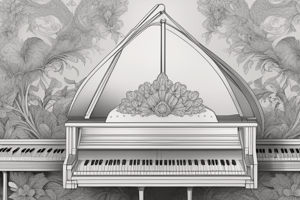Podcast
Questions and Answers
What is the purpose of finger exercises for piano players?
What is the purpose of finger exercises for piano players?
To develop strong and nimble fingers for achieving musical expression and technique.
Why are scales and arpeggios considered fundamental finger exercises for pianists?
Why are scales and arpeggios considered fundamental finger exercises for pianists?
They involve playing each note of a scale or chord in a specific order, helping build finger independence and agility.
How do interval exercises benefit piano players' finger dexterity?
How do interval exercises benefit piano players' finger dexterity?
Interval exercises focus on the distance between two notes, improving finger control and dexterity.
What is the main purpose of chord exercises for piano players?
What is the main purpose of chord exercises for piano players?
Why is it recommended to start with one octave when practicing arpeggios?
Why is it recommended to start with one octave when practicing arpeggios?
How can playing intervals like sixths benefit piano players?
How can playing intervals like sixths benefit piano players?
What is the purpose of warm-up exercises for piano?
What is the purpose of warm-up exercises for piano?
How do alternate finger exercises benefit piano players?
How do alternate finger exercises benefit piano players?
What is the goal of sight-reading exercises for piano?
What is the goal of sight-reading exercises for piano?
What are some common mistakes to avoid during finger exercises?
What are some common mistakes to avoid during finger exercises?
Why is it important to incorporate a variety of exercises for finger training?
Why is it important to incorporate a variety of exercises for finger training?
How can proper posture and ergonomics contribute to effective finger exercises?
How can proper posture and ergonomics contribute to effective finger exercises?
Flashcards are hidden until you start studying
Study Notes
Finger Exercises for Piano Players
As a pianist, developing strong and nimble fingers is essential for achieving your desired musical expression and technique. Finger exercises are a crucial aspect of learning the piano, helping you build flexibility, dexterity, and coordination. Here, we'll explore some popular and effective finger exercises to support your piano journey.
Scales and Arpeggios
Scales and arpeggios are fundamental finger exercises, as they involve playing each note of a scale or chord in a specific order. These exercises help build finger independence and improve agility. For instance:
- Playing major scales, beginning with a C major scale.
- Playing arpeggios, such as C major arpeggios.
Start with one octave and gradually work your way up to two or more octaves.
Interval Exercises
These exercises focus on the distance between two notes, or intervals. Interval exercises help improve finger dexterity and control, and they are also beneficial for learning to play chords accurately. Some examples include:
- Playing major and minor thirds, starting from the C major scale.
- Playing sixths, by playing the notes C, D, E, and F together, and then sliding the finger a semitone up or down.
Chord Exercises
Chord exercises help you build strength and coordination for playing chords. These exercises are beneficial for learning to play chord progressions, accompaniments, and more advanced piano pieces. Examples include:
- Playing major and minor chords in the C major scale, starting with the root position.
- Playing seventh chords.
Warm-Up Exercises
Warm-up exercises are simple yet effective ways to prepare your fingers for playing. These exercises help improve finger dexterity, coordination, and flexibility, and they are also beneficial for preventing injury. Some examples include:
- Playing single notes on each finger, one at a time, in a slow, deliberate manner.
- Playing a C major scale, starting on different fingers and gradually incorporating all fingers.
Alternate Finger Exercises
Alternate finger exercises are beneficial for improving finger independence and coordination. These exercises help you build a strong foundation for playing complex passages and arpeggios. Examples include:
- Playing a C major scale, using alternate fingers (1-2-3-4 or 1-4-3-2) for each note.
- Playing a C major scale, using alternating hand positions (left hand plays 1-2-3-4, while right hand plays 4-3-2-1).
Sight-Reading Exercises
Sight-reading exercises help you improve your ability to read and play complex piano pieces. These exercises are also beneficial for building finger strength and coordination. Examples include:
- Playing simple melodies or accompaniments, such as a C major scale or C major arpeggio, without looking at the music.
- Playing excerpts from popular piano pieces.
Common Mistakes and Tips
- Focus on finger technique and avoid relying solely on arm and wrist movements.
- Be patient and practice regularly to see progress.
- Incorporate a variety of exercises to keep your fingers engaged and challenged.
- Listen to your own playing and evaluate your sound quality.
- Avoid rushing through exercises and focus on accuracy and precision.
- Practice proper posture and ergonomics to prevent injury.
- Have a positive attitude and enjoy the process of learning and practicing.
Remember that finger exercises are essential for building a strong foundation for playing the piano. By incorporating these exercises into your regular practice routine, you'll be well on your way to improving finger dexterity and coordination. Happy practicing!
Studying That Suits You
Use AI to generate personalized quizzes and flashcards to suit your learning preferences.




